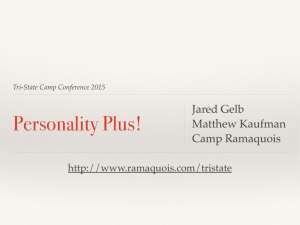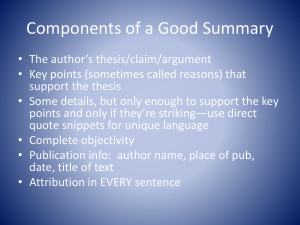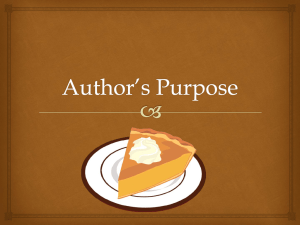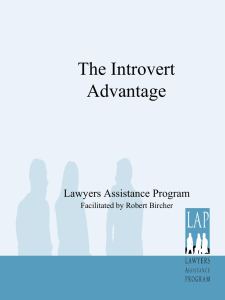Integrating Sources--MLA
advertisement
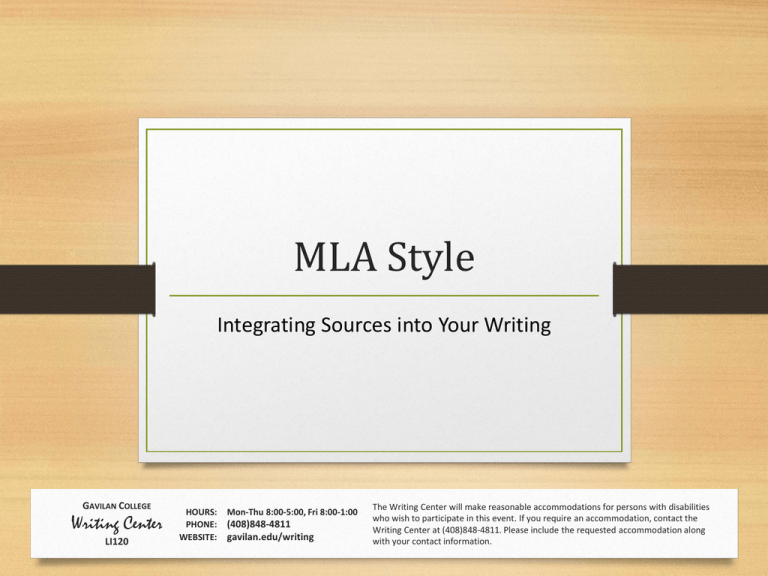
MLA Style Integrating Sources into Your Writing GAVILAN COLLEGE Writing Center LI120 HOURS: PHONE: WEBSITE: Mon-Thu 8:00-5:00, Fri 8:00-1:00 (408)848-4811 gavilan.edu/writing The Writing Center will make reasonable accommodations for persons with disabilities who wish to participate in this event. If you require an accommodation, contact the Writing Center at (408)848-4811. Please include the requested accommodation along with your contact information. Research Process Establishing a Purpose (Research Question(s), Topic Proposal, Working Thesis Statement) Finding Sources Evaluating Sources Understanding Academic Articles Integrating Sources MLA Style: Citing Sources Revising Your Essay Proofreading Review For each Does the source meet source: the requirements of the assignment? Type of source Checked for credibility So what? Why did you pick this source instead of another? Who cares? What is your reader going to get out of having this source in your paper? What work is this source going to do in your paper? Integrating Why here? Why this? Why Integrate Sources? Definition Presenting and using information from other sources in order to develop and strengthen your own ideas Reasons 1. To give background information so reader understands topic. 2. To put your ideas inside of a larger conversation: you first have to say what other people say in order to have something to respond to. 3. To make what you have to say more meaningful by putting it next to what other people say. 4. To build stronger arguments. 5. To establish your credibility: the reader is more likely to believe what you say if you’re fair to the other side. Steps 1. Decide how the information or ideas will be useful to you. 2. Decide which is appropriate: summary, paraphrase, or quotation. 3. Integrate the source into your paper using MLA Style guidelines. Reading and Annotating Source Material example of quiet determination Is this really (just) a “Chinese” thing? What determines parents’ pride in their kids? success=? what is connection between Cupertino has an insulated, introverted culture + that’s what these white parents aren’t comfortable with? are these qualities most people want/ desire? They are leaving b/c of thoughtful + dedicated kids?? Why? Because they are scared of failure? or something else? Cupertino = admiring quiet intelligence vs. Tennessee = smart people are on margins, don’t have lots of friends bad at sports = good at school When introversion is the norm, are extroverts frowned upon? Is this why white parents are taking kids out of Cupertino? How is this source useful to you? • How is this source helping you enter into the larger • • • • • conversation? How is this source enriching your understanding of your subject/topic/argument? Does this source change the way you think about the topic? Does this source give the reader an alternative perspective or help them look at your topic in a different way? Is it going to help the reader understand what you’re trying to say? Does this source support your argument or agree with your perspective? Does this source oppose your argument or disagree with your perspective? Incorporate the Information Signal and introduce The information (summary, paraphrase, quotation) Interpret: explain and connect The Information There are three ways to incorporate information. Summary Put only the main ideas from a source into your own words using as few words as possible. Paraphrase Put a short passage into your own words, sentence structure, and style without changing the author’s original meaning. Quotation Copy the source material word for word without changing anything. Signal & Introduce A signal phrase is made up of certain information. “But” suggests a contrast between previous next Alerts thethe reader as toand why you idea. chose to include this information. Author’s name Title of the source Interpretation (Explain & Connect) Information isn't meaningful by itself. It is the writer’s job to make the information meaningful by interpreting it for the reader: to explain the significance of the information, to connect it to other ideas in the paper, and to tell the reader why they should care about it. Here are some ways to do that: Explain the information in your own words to clarify what it means to your argument or ideas. Analyze the information--agree, disagree, agree with a difference Point out to your reader why this information should be meaningful to them. Connect the information to an idea you already stated earlier in your paper. If the information is supporting an idea you've written, tell the reader what that connection is. If the information disagrees with your point of view, tell the reader why you disagree. Incorporate Information: Summary Use summary when you want to include just the main ideas from a source. Summary is the most common way to incorporate sources into your own writing. You might summarize the main ideas of an entire article or chapter in a few sentences or short paragraph. Be concise: use as few words as possible. Put only the main ideas from a source into your own words. Incorporate Information: Summary When you ask most people to list the popular kids in high school, they probably fill the list with athletes, cheerleaders, and other extroverted types. It is the introverted academic achievers who get overlooked. But according to Susan Cain, in Quiet: The Power of Introverts in a World that Can’t Stop Talking, mainstream American culture celebrates extroverts, making them more familiar and popular than introverts (182-3). As with anything, we tend to forget, or even worse, to fear things we aren’t familiar with or don’t understand, and American families feel threatened by introverts or cultures that place value on introversion. Incorporate Information: Paraphrase Use paraphrase when you want to use most or all of the information from a short passage from a source. Change the language and style of a text to make the information of the source more useful to you. Use paraphrase when you want to include WHAT the original author said, but not HOW they said it. Use paraphrase to make information fit better into your writing style or to clarify what the original author said for your readers. Incorporate Information: Paraphrase As with anything, we tend to forget, or even worse, to fear things we aren’t familiar with or don’t understand, and American families feel threatened by introverts or cultures that place value on introversion. For example, many white American families are moving away from Cupertino because they are afraid that their children won’t be able to compete academically with the determined, high-achieving AsianAmerican students in Cupertino’s schools (Cain 182). When people feel threatened, they get defensive and try to get away from the threat, but pulling children out of really great schools just because you are afraid of failure seems like a terrible idea. Incorporate Information: Quotation Use quotation when you want to include exactly what a source says without making any style, word, or other changes. Quotations are exact copies. Quotations should only be used when everything the writer said is important to your paper, or when changing the writer's style or language makes it less significant to your own writing. Use quotation when you want to include WHAT the original author said exactly HOW they said it. Incorporate Information: Quotation Cain believes that it is an introversion-valuing culture in Cupertino that fosters these successes because the students are proud of “having a lousy football team” (183), and as Chris, one Korean-American student, puts it, “‘the really smart people usually have a lot of friends, because they can help people out with their work’” (Cain 183). Perhaps if white American families can learn to value quiet, introverted people as much as jocks or cheerleaders, then we can change mainstream American culture to be more accepting of introversion. And if we can do that, then the next generation of graduates will remember more of those quiet academic achievers from high school because they will all have the chance to be them. Review When you ask most people to list the popular kids in high school, they probably fill the list with athletes, cheerleaders, and other extroverted types. It is the introverted academic achievers who get overlooked. But according to Susan Cain, in Quiet: The Power of Introverts in a World that Can’t Stop Talking, mainstream American culture celebrates extroverts, making them more familiar and popular than introverts (182-3). As with anything, we tend to forget, or even worse, to fear things we aren’t familiar with or don’t understand, and American families feel threatened by introverts or cultures that place value on introversion. For example, many white American families are moving away from Cupertino because they are afraid that their children won’t be able to compete academically with the determined, high-achieving Asian-American students in Cupertino’s schools (Cain 182). When people feel threatened, they get defensive and try to get away from the threat, but pulling children out of really great schools just because you are afraid of failure seems like a terrible idea. Cain believes that it is an introversion-valuing culture in Cupertino that fosters these successes because the students are proud of “having a lousy football team” (183), and as Chris, one Korean-American student, puts it, “‘the really smart people usually have a lot of friends, because they can help people out with their work’” (Cain 183). Perhaps if white American families can learn to value quiet, introverted people as much as jocks or cheerleaders, then we can change mainstream American culture to be more accepting of introversion. And if we can do that, then the next generation of graduates will remember more of those quiet academic achievers from high school because they will all have the chance to be them. Additional Resources Handbooks A Writer’s Reference by Diana Hacker Websites OWL Purdue Gavilan College Library GAVILAN COLLEGE Writing Center Rules of Thumb: A Guide for Writers by Jay Silverman LI120 HOURS: PHONE: WEBSITE: Mon-Thu 8:00-5:00, Fri 8:00-1:00 (408)848-4811 gavilan.edu/writing

